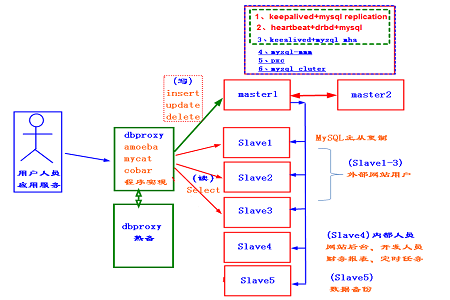What do large companies use for mysql clusters?
In small and medium-sized Internet companies. MySQL clusters generally have the architecture shown above. The WEB node reads the dbproxy server when reading the database. The dbproxy server separates reading and writing of the database by judging SQL statements. Read requests are loaded to the slave library (the master library can also be added), and write requests are written to the master library.

The dbproxy here is the only outlet of the database cluster, so it also needs to be highly available.
drproxy is a commonly used software for database read-write separation. amoeba, mycat, and cobar are also commonly used. This kind of software not only has the function of separation of reading and writing, but also can realize load balancing and health check of back-end nodes.
In addition to realizing the separation of reading and writing in the database through this type of database middleware software, it can also be written in the program.
Usually our main library needs to be dual-master high-available, so that if the main library fails, the other main library will take over immediately. If dual master is not used, state migration will be required when the slave database takes over the master database, which will cause a delay.

#The key point to consider for the high availability of the main database is data synchronization. The more commonly used high availability solutions are:
1, keepalived mysql replication. VIP elegance is achieved through keepalived, and data synchronization is achieved through replication, the synchronization solution provided by mysql.
2. hearbeat drbd. Dual-master data synchronization is achieved through DRBD. This data synchronization is based on block devices. Much faster than ordinary synchronization solutions. Realize VIP drift and DRBD resource switching management through heartbeat.
3. keepalived mha.
For slave libraries, it is best not to exceed 5. We can use three of them as nodes for users to access, and use the other one as a query node for insiders. Because when internal personnel query nodes, they usually query according to time periods without indexing, which takes up a lot of resources. Therefore, this node must be dedicated separately to avoid affecting customer access. Finally, we should leave a slave database for data backup of the database.
The data consistency of the slave database can be maintained through master-slave assistance directly from the master database, or master-slave replication from other slave databases (the advantage is to reduce the pressure on the master database, but the disadvantage is that the delay is slightly larger).
The above is the detailed content of What do large companies use for mysql clusters?. For more information, please follow other related articles on the PHP Chinese website!

Hot AI Tools

Undresser.AI Undress
AI-powered app for creating realistic nude photos

AI Clothes Remover
Online AI tool for removing clothes from photos.

Undress AI Tool
Undress images for free

Clothoff.io
AI clothes remover

AI Hentai Generator
Generate AI Hentai for free.

Hot Article

Hot Tools

Notepad++7.3.1
Easy-to-use and free code editor

SublimeText3 Chinese version
Chinese version, very easy to use

Zend Studio 13.0.1
Powerful PHP integrated development environment

Dreamweaver CS6
Visual web development tools

SublimeText3 Mac version
God-level code editing software (SublimeText3)

Hot Topics
 1377
1377
 52
52
 MySQL: The Ease of Data Management for Beginners
Apr 09, 2025 am 12:07 AM
MySQL: The Ease of Data Management for Beginners
Apr 09, 2025 am 12:07 AM
MySQL is suitable for beginners because it is simple to install, powerful and easy to manage data. 1. Simple installation and configuration, suitable for a variety of operating systems. 2. Support basic operations such as creating databases and tables, inserting, querying, updating and deleting data. 3. Provide advanced functions such as JOIN operations and subqueries. 4. Performance can be improved through indexing, query optimization and table partitioning. 5. Support backup, recovery and security measures to ensure data security and consistency.
 Can I retrieve the database password in Navicat?
Apr 08, 2025 pm 09:51 PM
Can I retrieve the database password in Navicat?
Apr 08, 2025 pm 09:51 PM
Navicat itself does not store the database password, and can only retrieve the encrypted password. Solution: 1. Check the password manager; 2. Check Navicat's "Remember Password" function; 3. Reset the database password; 4. Contact the database administrator.
 How to create navicat premium
Apr 09, 2025 am 07:09 AM
How to create navicat premium
Apr 09, 2025 am 07:09 AM
Create a database using Navicat Premium: Connect to the database server and enter the connection parameters. Right-click on the server and select Create Database. Enter the name of the new database and the specified character set and collation. Connect to the new database and create the table in the Object Browser. Right-click on the table and select Insert Data to insert the data.
 How to copy tables in mysql
Apr 08, 2025 pm 07:24 PM
How to copy tables in mysql
Apr 08, 2025 pm 07:24 PM
Copying a table in MySQL requires creating new tables, inserting data, setting foreign keys, copying indexes, triggers, stored procedures, and functions. The specific steps include: creating a new table with the same structure. Insert data from the original table into a new table. Set the same foreign key constraint (if the original table has one). Create the same index. Create the same trigger (if the original table has one). Create the same stored procedure or function (if the original table is used).
 How to view database password in Navicat for MariaDB?
Apr 08, 2025 pm 09:18 PM
How to view database password in Navicat for MariaDB?
Apr 08, 2025 pm 09:18 PM
Navicat for MariaDB cannot view the database password directly because the password is stored in encrypted form. To ensure the database security, there are three ways to reset your password: reset your password through Navicat and set a complex password. View the configuration file (not recommended, high risk). Use system command line tools (not recommended, you need to be proficient in command line tools).
 How to view mysql
Apr 08, 2025 pm 07:21 PM
How to view mysql
Apr 08, 2025 pm 07:21 PM
View the MySQL database with the following command: Connect to the server: mysql -u Username -p Password Run SHOW DATABASES; Command to get all existing databases Select database: USE database name; View table: SHOW TABLES; View table structure: DESCRIBE table name; View data: SELECT * FROM table name;
 How to copy and paste mysql
Apr 08, 2025 pm 07:18 PM
How to copy and paste mysql
Apr 08, 2025 pm 07:18 PM
Copy and paste in MySQL includes the following steps: select the data, copy with Ctrl C (Windows) or Cmd C (Mac); right-click at the target location, select Paste or use Ctrl V (Windows) or Cmd V (Mac); the copied data is inserted into the target location, or replace existing data (depending on whether the data already exists at the target location).
 How to execute sql in navicat
Apr 08, 2025 pm 11:42 PM
How to execute sql in navicat
Apr 08, 2025 pm 11:42 PM
Steps to perform SQL in Navicat: Connect to the database. Create a SQL Editor window. Write SQL queries or scripts. Click the Run button to execute a query or script. View the results (if the query is executed).




